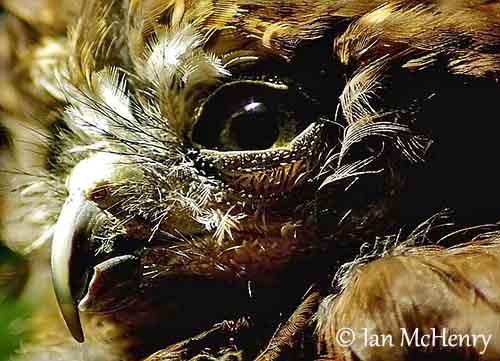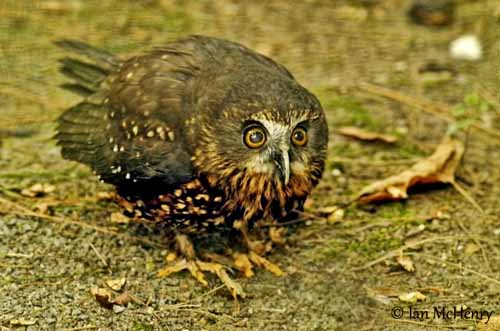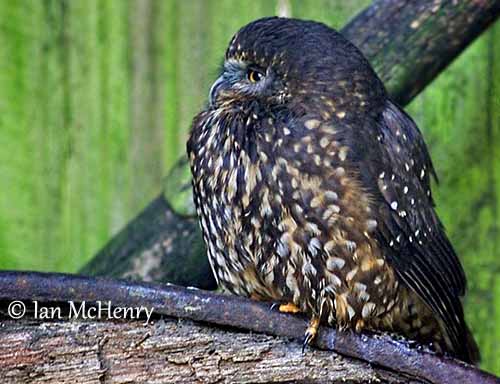
Fr : Ninoxe boubouk
All: Kuckuckskauz
Esp: Nínox Maorí
Ita: Civetta Bookbook
Nd: Nieuw-Zeelandse Boeboekuil
Sd: Nya Zeelandspökuggla
Maori: Ruru
Photographer:
Ian McHenry
My New Zealand Birds
Text by Nicole Bouglouan
Sources:
HANDBOOK OF THE BIRDS OF THE WORLD Vol 5 by Josep del Hoyo-Andrew Elliott-Jordi Sargatal - Lynx Edicions - ISBN: 8487334253
KNOW YOUR NEW ZEALAND BIRDS by Lynnette Moon - New Holland Publishers – ISBN: 1869660897
BirdLife International (BirdLife International)
New Zealand birds and birding (Narena Olliver)
Te Ara – The Encyclopedia of New Zealand
WINGSPAN – National Bird of Prey Centre
Morepork
Ninox novaeseelandiae
Strigiformes Order – Strigidae Family
INTRODUCTION:
The Morepork is nocturnal and the only surviving native owl of New Zealand. Its night call is common in urban parks and gardens and in forest. At dusk, its melancholy song is typical and gives the birds its names (Morepork, Boobook and also the Maori name Ruru).
Like all the Strigidae species, it has silent flight due to the peculiar feather’s morphology.
DESCRIPTION OF THE BIRD:
Biometrics:
Length: 29 cm
Weight: M: 155g – F: 170g
The adult has dark pattern overall, round head, rounded wings and fairly long tail.
The upperparts are dark brown to deep rufous, with whitish spots.
The underparts are slightly paler with buff to dark brown flecks and streaks.
The head is dark brown with indistinct pale greyish facial disk. We can see whitish or cinnamon eyebrows.
The bill is pale grey to horn. The eyes are golden-yellow. The feathered tarsi are rufous-brown and the feet are yellow with black claws.

The female has similar appearance but with more markings on head and back. She is slightly larger than male.
The juvenile is often more heavily streaked than adults, especially on crown, nape and breast.
SUBSPECIES AND RANGE:
The Morepork has three subspecies which differ in size and plumage colours and pattern.
N.n. leucopsis occurs in Tasmania and Bass Strait Islands. This race shows more conspicuous white spotting.
N.n. undulata is found on Norfolk Island. This one has more barred upperparts and more rufous underparts.
N.n. novaeseelandiae (here described) occurs in New Zealand and several offshore islands.
HABITAT:
The Morepork is mainly a forest bird, but it can be found in open country too, where mature trees provide it good shelter.
It can be found from lower elevations up to the tree line.
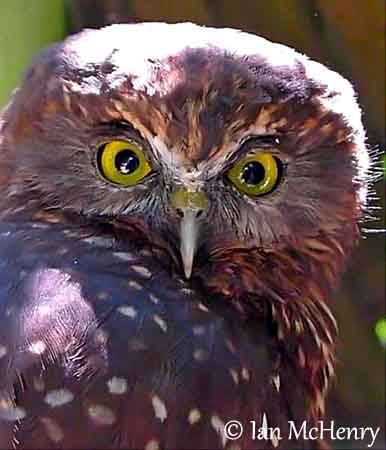
CALLS AND SONGS: SOUNDS BY XENO-CANTO
The Morepork utters characteristic “quor-quo, quor-quo” and a repeated double hoot “boo-book” which is the commonest call. We can also hear soft, vibrating “cree-cree” during the breeding season. At the nest-site, the male produces mewing and rippling sounds.
It is more vocal through the night and just before dawn, and during the breeding season.
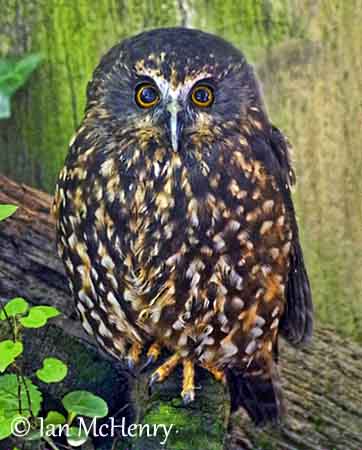
BEHAVIOUR IN THE WILD:
The Morepork begins to hunt at dusk. It preys on large insects such as weta, cicadas, beetles and large moths. But it also takes geckos, frogs, mice and small birds. However, its diet varies according to the seasons. It regularly rejects indigestible pellets.
When it is hunting, the Morepork is alert and motionless. The short, rounded wings allow the bird to fly among trees in forest. It has fast and silent flight, thanks to the velvet-like upper surface of the flight feathers and the soft fringes. The approach is not heard by the preys and the Morepork can detect its victim more easily. It has acute hearing and large eyes sensitive to light. It swoops down onto the prey and catches it with its sharp talons. Then, it carries it in the bill.
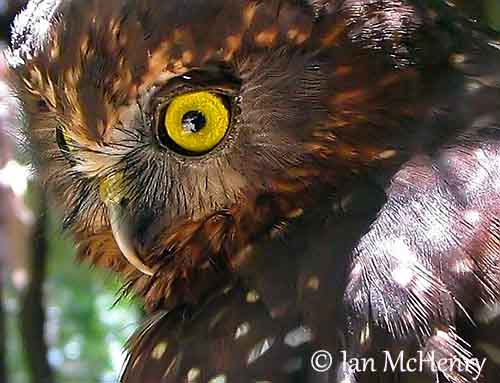
The Morepork defends strongly its territory, and the calls of the fighting males are often heard during the breeding season. This species is monogamous. They roost during the day and often sleep in tree hole under the thick canopy. They are sometimes harassed by small birds, and the Moreporks leave their roost and fly away in daylight.
It is resident in its range, but the young birds often disperse in winter, reaching some offshore islands.
It flies silently and rapidly. The noise of the air passing over the wings is muffled by the serrated edges of the flight feathers, enabling silent flight.
REPRODUCTION OF THIS SPECIES:
The breeding season takes place between September and February.
The Morepork usually nests in hollow in tree, or within broken logs, in tree fork, in hole in earth bank and sometimes in petrel’s burrow, and even on the ground in clumps of astelia on under tree fern fronds. The nest-site must provide a dark hideaway. Only wood dust and pine needles are added to the hole.
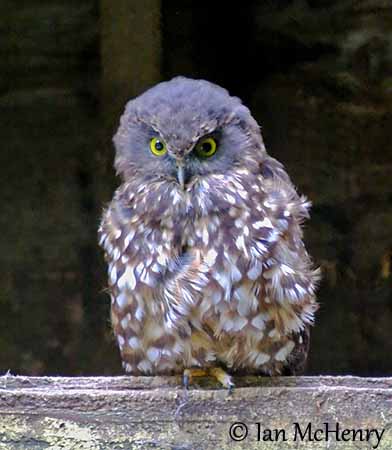
The female lays 1-3 white eggs, and incubates alone during one month. At hatching, the chicks have greyish-white down, but the second down is mostly sooty-grey. They have yet the golden-yellow eyes.
They are fed by both parents. The male brings the preys to the female, and she tears off pieces that she gives to the chicks. They fledge five weeks after hatching, but they remain in family group for several weeks.
PROTECTION / THREATS / STATUS:
The Morepork is usually abundant in New Zealand, but it is threatened by the introduced predators such as cats, rats, possums and mustelids which are nest predators. They are vulnerable to poisoning from pest control management. These pests are included in its diet.
The race “leucopsis” is widespread in Tasmania.
The race “undulate” is endangered on Norfolk Island due to forest clearing.
But the population appears currently stable, and the Morepork is evaluated as Least Concern.
